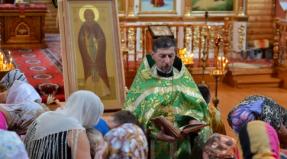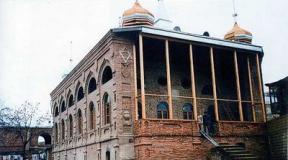Notterdam de Paris Cathedral history. Notre dame de paris - notre dame cathedral

Notre Dame Cathedral or Notre Dame de Paris
Daria Nessel | Apr 16, 2019
Notre Dame Cathedral (Notre Dame de Paris) is the most famous sacred building in Europe, a grandiose, majestic and a bit gloomy cathedral located in the French capital, which is certainly beautiful. It amazes with its cultural heritage, attracting tourists from all over the world.
A bit of history
Previously, there was a small church on this site, and nearby is the cathedral complex of the Mother of God. In the 12th century they were partially destroyed, and Bishop Maurice de Sully decided to build a new structure.
In 1163, Pope Alexander III blessed the construction. In addition to supporters, there were also a large number of opponents of the construction, so Bishop Bernard protested and believed that the treasury would not bear such an expensive event, moreover, at that time famine reigned in the country.

The construction of Notre Dame de Paris dragged on and lasted almost two centuries. More than a dozen architects, masons, blacksmiths worked on the facade. It was completed in 1345. Due to the lengthy construction, several architectural and artistic styles can be seen.
Not only has Notre Dame Cathedral become a sacred symbol of the city, but also participated in many historical events of the country and the world. So, Marguerite Valois married in him with Henry of Navarre. It was ridiculous that the newly-made spouse was not even allowed into the hall, since he was a representative of a different faith. Heinrich stood in a small courtyard near the main doors, and his future wife remembered all the main moments of the wedding, passing them on to the groom. After ten years, they repeated the ritual, when Henry still converted to Catholicism, becoming king.
In 1804, the coronation of Napoleon took place within the walls of the cathedral.
But the sacred structure was not always given such an honorable place. During the reign of Louis XIV, most of the tombs and stained glass windows were brutally destroyed, relics and valuable exhibits were destroyed. After that, it took a lot of time and money to reconstruct and restore the building and internal halls.
A sad event happened in our time with the cathedral. On the evening of April 15, 2019, there was a fire in Notre Dame Cathedral. The tower collapsed and the entire building was badly damaged. At the moment, restoration work is underway, let's hope that such a great building will again delight the eyes of tourists and local residents.
Interior of Notre Dame Cathedral
Going inside Notre Dame Cathedral, you will plunge into the twilight, even incredibly beautiful stained glass windows made of colored glass cannot save you. At the entrance, according to tradition, there is a small souvenir shop where you can buy souvenirs, postcards and other attributes.
The main hall has benches and chairs for the service. Here you can often see believers quietly reciting a prayer. As a sign of respect in the halls, you need to be quiet so as not to interrupt the peace of the parishioners.
Admiring the ceilings with massive vaults and patterned arches, you should go to the chapels - small rooms with an altar and a bench. In the first two niches there are paintings with images of St. Stephen and Andrew.

Having passed a little forward, you can see the passage to the main altar, on the sides you can not fail to notice the rounded stained glass windows.
On the right side there is a treasury where a genuine relic is kept - the crown of thorns of Christ, a part of the cross and a nail where he was crucified.
Above the altar rises the figure of Dame de Paris - the mother of God. At its foot there are always baskets and armfuls of white flowers.


The interior of the Cathedral of Notre Dame de Paris
In addition to all this, you can look at a strange chandelier of unrealistic dimensions, many tombs where priests are buried and an organ of amazing beauty, and in a separate room there is a whole collection of dolls with the main characters of sacred stories.
Legends of Notre Dame de Paris
For many centuries, the cathedral was a real book; the entire history of the Christian world was depicted on its facade.
Many esotericists consider the cathedral "a reference book of the occult." There is a legend that within the walls of Notre Dame de Paris, a code laid down by the first architects was encrypted. Having solved the code, he will find out where one of the most mysterious world relics is hidden - the philosopher's stone, capable of working miracles, resurrecting from the dead, giving eternal life.
Another story tells about the participation of the lord of the underworld, who had a hand in the construction. So, the blacksmith was ordered to forge a gate of incredible complexity. For several days the master tried to complete the work, but it was all to no avail, the blacksmith called on the devil's forces for help. The next morning, at the central entrance, they found the lifeless body of a poor fellow and an incredibly beautiful gate. They were immediately installed, but another problem was discovered, they could not be opened. The builders turned to the servants, who, in turn, sprinkled the castles with holy water, only after that they were able to open them. Until now, blacksmiths cannot recreate the technology by which the gate was forged, the second such no longer exist.

Gargoyles and Chimeras of Notre Dame Cathedral
While examining the Notre Dame Cathedral, one cannot fail to notice the frightening figures, and this is not an easy decorative decoration, they are filled with secret and parochial content.
Chimeras have been considered silent guards of holy places since ancient times. With the onset of night, when dusk falls on the city, they come to life, bypass their eternal possessions, keeping the peace of the buildings. As conceived by ancient architects, they show the whole essence of man, many characters and traits: sadness, anger, a smile, joy or stone tears.
The figures are like living beings, there is a legend that if you watch them for a long time in the twilight, you will notice that the stone gradually comes to life. Do not forget to take a picture with the chimera, and no matter how hard you try, you will still seem like a stone statue.
The cathedral even has a whole gallery of sculptures located in the north tower. To look at them, you only need to go through 387 steps, here you will see a unique collection, and enjoy a stunning view of.

The crown of the Notre Dame collection is the Strix chimera. The Night Demon, despite the male name, is a half-female, half-bird, emitting a heartbreaking cry in the darkness. According to legends, she feeds on the blood of newborns, abducts small children with her paws with huge, sharp claws.
Unlike chimeras, gargoyles on the facade of the building appeared later, only in the Middle Ages. These two mythical creatures perform completely different functions.
In translation, a gargoyle is a drainpipe, so it's not even a monster, but just a pipe decoration. The streams do not flow down in a chaotic manner, but with the help of the drainage system they evenly flow down in the right places, directly into the sewer hatches.
- In 1944, the allied troops entered the capital, the city had not yet been completely liberated from the Germans, but the townspeople, not waiting for a complete victory, rang the bell, meaning good news.
- The roof of the temple weighs two hundred tons, all because of the large number of lead plates, then they did not yet know about its harmful properties.
- Victor Hugo created his masterpiece of the same name (novel) not only because of his love for art, he wanted to attract attention, while there were rumors about the demolition of the building.

The real heart of Paris and all of France is the majestic ancient Cathedral of Notre Dame de Paris. The brightest monument of medieval culture and architecture has repeatedly stood on the brink of destruction, but endured all the hardships assigned to it with honor. For more than a thousand years, Notre Dame Cathedral in France has preserved the mystical energy of these places. Millions of tourists make pilgrimages to touch its walls. Glorified by poets and writers, the temple proudly bears the crown of the symbol of the French capital. There are very few buildings left in the world today that can compete with Notre Dame Cathedral in majesty and the depth of historical destiny.
You don't have to be a believing Christian to fully appreciate the cathedral. Foreign tourists in Paris always come to Notre Dame Cathedral. He has an official website, which tells the history of the place, you can sign up for an excursion, find out more interesting information.
History of Notre Dame Cathedral.
On the territory where Notre Dame Cathedral is located, in pagan times there was a temple where Jupiter was worshiped. Even then, these lands were considered sacred, filled with mysterious power. When Christianity came to France, the once important pagan shrine was destroyed. Its place was taken by the Basilica of St. Stephen. This building was actually the first Christian temple in medieval Paris. The corner of the Cito Island, where Notre Dame stands today, has always been especially revered by the locals.
1163 year. The beginning of the construction of the cathedral. At a deliberately chosen place (according to the order of King Louis 7), the first stone of the future structure was laid. The skeletons of the foundations of a Romanesque cathedral were used in the work.
The construction took place in two stages (it actually lasted 200 years). For Medieval Europe, such a construction was familiar. In addition, for many centuries, Notre Dame was restored, updated, rebuilt. The main altar was built relatively quickly: it was ready 20 years after the start of work. The future cathedral was used as a burial place for the aristocracy, rulers of France.
Two centuries of construction work have created the pristine appearance of Notre Dame. The sacred place remained untouched for half a millennium. The greatest architects of medieval France, Pierre de Montero and Jean de Chelle, had a hand in its creation. De Montero is the architect of many French architectural monuments of the Middle Ages:
- Abbeys of Saint Denis;
- The Abbeys of Saint-Germain-des-Prés;
- Other constructions in the "Radiant Gothic" style.
Both creators are buried after death in their greatest building.
The year is 1789. By that time, the building was dilapidated. No one was involved in maintaining order in the temple. The decline began even under Louis 14. The Great French Revolution, the upheavals that gripped the country, did not pass by the great cathedral. Maximilian Robespierre declared Notre Dame a symbol of obscurantism. The revolutionaries destroyed the spire on the main tower of the building. They were going to blow it up entirely. The rebels demolished the heads of numerous statues of Notre Dame Cathedral and plundered a rich treasury. The caring people of France obediently paid taxes to the treasury of the Jacobins, keeping Robespierre from blasphemous actions.
1804 Napoleon Bonaparte chose Notre Dame as the site of the imperial coronation. Much for the cathedral did not save it from further destruction. Over the next decades, the question of the demolition of the temple was raised several times.
1831. An event that turned the history of Notre Dame happened. Victor Hugo's novel "Notre Dame Cathedral" so shook the hearts of Parisians, so exalted the ancient temple that he literally saved the historic building from destruction. No one was left indifferent before describing the dilapidation and decay of the cathedral. Hugo achieved his goal perfectly. Inspired the French to love the monument of historical architecture. After 10 years, the full-scale restoration of Notre Dame de Paris began. The building has acquired a familiar modern look. The famous gargoyles and chimeras of Notre Dame Cathedral appeared, a find by the architect Viollet-le-Duc (the father of modern architectural restoration).
21 century. For the 850th anniversary of Notre Dame Cathedral inside was restored: the organ was renewed, new bells were cast. A “pilgrim's route” has been developed for tourists, opening a veil over all the secrets of Notre Dame. The number of annual pilgrims reaches 14 million, making the Cathedral one of the top tourist attractions in France.
Treasury of Notre Dame de Paris
Such a famous church building could not do without rich Christian relics. The most famous value of Notre Dame Cathedral is the crown of thorns. France acquired the crown of Christ in the 13th century, but it was transferred to the cathedral after the end of the French Revolution. King Louis the Ninth is to be thanked for an important acquisition.
In addition, other relics associated with Jesus Christ are also present here:
- one of the nails with which the body of the Messiah was nailed to the cross;
- detail of the cross.
Today there is debate over whether the nail stored in Notre Dame can really be called a Christian value. Similar assets are kept in multiple copies all over the Earth, although there are only 5 original nails. This does not prevent people from coming to the temple, full of confidence that such important elements of the execution of Christ are kept here.
A separate value of Notre Dame is its organ. First installed in the 15th century, it has undergone several renovations (1733, 1788, 1868). The organ was computerized for the convenience of the players in 1992, but has not lost its original sound. The instrument has been restored to its historical appearance from the era of Louis the Sixteenth.
Today the organ has more than a hundred registers, seven and a half thousand pipes, some of which have been preserved since the 18th century. There are no instruments in France that can compete with the Notre Dame organ in scale. At least three titular organists are involved to play the organ simultaneously. Music lovers of the world rightfully consider the sound of the Parisian instrument to be amazing.
Architecture of Notre Dame Cathedral
The architectural style of the building is typical of the Gothic period, but retains the features of the Romanesque early medieval architecture of Normandy. The structure of the Cathedral is of strict symmetry: two famous towers on the facade, three horizontal and vertical parts.
The building cannot be called monumental. But for its time it was large: the maximum height is 69 meters, the height of the facade is 35 meters. The Cathedral is almost 150 meters long. To climb the bell tower, you have to climb almost 400 steps. It's worth it, as the bells of Notre Dame are a separate treat. Each of them is named after female names. Emmanuel is the largest bell, its weight reaches 12 tons, and the "tongue" weighs another half a ton. Named after the heroine Hugo Belle, the oldest bell, smelted in 1631. It was a divine miracle that saved the bells from looting during the French Revolution. You can hear the sounds of bells ringing over Paris every morning at 8.
In addition, a beautiful Parisian landscape opens up from the site of the bell tower. Many people find it more interesting and romantic than the view from the Eiffel Tower.
Three entrances lead to the Cathedral. Thematic design of the Central Portal - The Last Judgment. There is a symbolic representation of all segments of the population here:
- power and aristocracy - the king who rose from the grave;
- clergy - the Pope;
- other population - women and men-soldiers.
The left portal is named after the Madonna and Child. Here is one of the most famous sculptures ("Glory of the Blessed Virgin"). Thematically, the portal is decorated with paintings depicting the most important milestones in the life of the Virgin and the birth of Christ. On the right side is the portal of St. Anne.

The chimeras I have already mentioned are shrouded in many legends. They are considered the keepers of the cathedral, who come to life at night. Gargoyles, crowning the drainpipes, also, according to legend, "come to life". If you believe the myths, these sculptures keep the ancient structure from ill-wishers and adversity.
Cathedral inside
The famous stained glass rose of Notre Dame Cathedral is located on the central facade of the building. The window diameter is more than 10 meters. Other stained-glass windows-roses are also on the other facades (their size is smaller). Around they are decorated with scenes from the Old Testament.

Stained-glass windows are the hallmark of the place. There are no walls inside the cathedral, only columns. Stained glass plays an important role in zoning space. Notre Dame is especially beautiful in clear, sunny weather: the light plays with multi-colored glass, creating an unforgettable play of color on a gray ancient stone. Although the interior of the temple is simple, thanks to the stained-glass windows it has a unique look and volume.

During the restoration of the 19th century, a central chandelier appeared in the Cathedral. Viollet-le-Duc, who supervises the work, personally drew sketches of the lighting fixture. Material - bronze, silver-plated.
The interior of Notre Dame cannot be called rich. It differs from the Orthodox churches we are accustomed to. There is no luxury here, no gold. Stained glass overflows, ancient statues and the identity of architecture - that's what makes Notre Dame majestic and luxurious in all its simplicity.
How to get to Notre Dame Cathedral
You can see Notre Dame Cathedral in many feature films and documentaries. Not a single historical film about the life of Paris is complete without a view of the temple. It is much better to see the structure in real life.
The ideal excursion is on foot (in the Fourth arrondissement of Paris, the oldest district). The Ile de la Cité will surprise you with its many architectural delights, not only Notre Dame de Paris: Conciergerie, Sainte Chapelle, Place Dauphin.
Be sure to linger in the Cathedral Square. There are 7th century buildings, the archaeological museum "Crypt of the Porch of Notre Dame". Also, attention is drawn to the "zero kilometer" - the point of intersection and the beginning of all French roads from the time of the medieval state.
Building opening hours start from 8 am to 7 pm. 8:30 am - the beginning of the morning mass. Getting inside is completely free. But you will have to pay 15 euros to climb to the bells. The treasury has a different schedule: 9:30 am - 6:30 pm.
The most convenient way to get to Notre Dame is by metro. There are 6 different trains running here. Remember the names of the stations where you need to exit:
- Saint-Michel;
- La Sorbonne;
- Chatelet;
- Hotel de Ville.
There is also an electric train (RER), the exit station of which is called Notre-Dame.
If you have no desire to go by metro, catch a taxi. Any self-respecting taxi driver will take you to Notre Dame Cathedral with a breeze. There is not a single person in Paris who does not know the way to the most famous beautiful cathedral.
In ancient times, on the site of Notre Dame Cathedral there was a Gallo - a Roman temple dedicated to the god Jupiter, with the advent of Christianity, the temple gave way to a basilica.
In 1163, Bishop Maurice de Sulli began the construction of Notre Dame Cathedral (Notre Dame de Paris) on this site. The choir was first built, and then, between 1180 and 1245, the main façade and towers were added at the initiative of Bishop Ed de Sulli. Under the direction of the architect Jean of Shell, the nave and choir chapels were erected.
Around 1250, according to the design of the same Jean of Shell, the facade of the north wing of the transept was built, and eight years later, construction began on the facade of the south wing, designed by Pierre of Montreuil. The construction of the cathedral was completed in 1345.
In the 13th - 14th centuries, Notre Dame was a concentration of spiritual power, six bishops emerged from the walls of the seminary of the cathedral, but later it ceded primacy to other dioceses of the city with centers in the cathedrals of Reims and Saint Denis.
Sasha Mitrakhovich 20.12.2015 13:40

The story begins in ancient times, then on the place where the Gallo now stands - a Roman temple dedicated to the god Jupiter. With the strengthening of the influence of Christianity, the ancient pagan temple gave way to a basilica.
In 1163, at the behest of Bishop Maurice de Sulli, construction began on this site. The choir was first built, and then, between 1180 and 1245, the main façade and towers were added at the initiative of Bishop Ed de Sulli. Under the direction of the architect Jean of Shell, the nave and choir chapels were erected.
Around 1250, according to the design of the same Jean of Shell, the facade of the north wing of the transept was built, and eight years later, construction began on the facade of the south wing, designed by Pierre of Montreuil. Construction work ended in 1345.
In the Cathedral of Notre Dame, the crusaders offered prayers of grace before the campaigns behind the Holy Sepulcher, within these walls the parliament gathered for the first time. In 1422, Francis II and Mary Stuart were married in the cathedral, and 150 years later, Henry of Navarre and Marguerite de Valois. Wealthy Parisians were confident in the safety of this place and carried their valuables here.
Sasha Mitrakhovich 20.12.2015 13:58

When Louis XIV was king, he began to lose his significance and influence, the tombs within the walls of the temple were plundered and the magnificent stained glass windows in roses were broken and destroyed.
The situation of the Council was further aggravated by the outbreak of the French Revolution. The plans of the leader of the Jacobin movement, Robespierre, included the complete destruction of the cathedral. But the inhabitants did not want to lose their magnificent temple and collected ransoms in favor of the revolutionaries.
The Cathedral itself was saved, but the heads of the sculptures of the Jewish kings on the facades were cut off, and unique bells and gravestones were melted down into cannons and bullets. The great treasures of the temple were plundered, and a wine warehouse was organized within the walls of the great structure.
The coming to power of Napoleon I brought the already dilapidated and destructive building of the Paris Cathedral back to life. Napoleon chose this temple for his coronation as emperor, and the shabby walls were draped and pompously decorated for a magnificent ceremony.
Time, negligence of people, wars and attempted robberies caused significant damage to the building of the cathedral, and in 1844, under the leadership of E.E. Viollet - le - Duc began restoration work, which was completed in 1864.
Sasha Mitrakhovich 20.12.2015 14:16

Victor Hugo, the plot of his popular novel "Notre Dame Cathedral", in which he described in detail the deplorable state of the building, brought back public interest in the great temple
)
Metro: Cite or St-Michel RER: St-Michel
Working hours: from 8:00 to 18:45 (until 19:15 on Saturdays and Sundays)
Entrance: admission to the cathedral is free. In the towers - 8 Euros for adults, 5 Euros from 18 to 25 years old, up to 18 years old free.
N.B .: Free guided tours of the cathedral in Russian are held every Wednesday at 14:00
and Saturday at 14:30
Photo: a selection of photos is available in the Photogallery section
Website: www.notredamedeparis.fr
In the very heart of Paris, on the eastern part of the Ile de la Cité, the pearl of French Gothic architecture - Notre-Dame de Paris Cathedral - Notre-Dame Cathedral - stands majestically.
Since the construction, which lasted a total of about two centuries, was begun in 1163 by Bishop Maurice de Sully on the Holy Land, where the church, built by the Romans, and then the Christian basilica were located. Bishop de Sully spent a significant part of both his fortune and his life on the construction of the Cathedral.
Upon completion, the majestic Notre Dame de Paris Cathedral, with its magnificent interior decoration, served for centuries as the site of royal weddings, imperial coronations and lavish national funerals.
During the French Revolution in the 1790s, Notre-Dame de Paris, like most other religious and monarchical symbols of the country, suffered greatly. So, for example, mistaken for the images of the kings of France, stone statues of the biblical kings of Judea were literally beheaded (a number of elements of the statues that had been vandalized were found only in the 20th century).
The restoration of the cathedral, which was in an extremely deplorable state, began only in 1845 under the direction of the architect Eugene Viollet-le-Duc and lasted more than twenty years. During this time, in addition to recreating the original appearance of the cathedral, the architect erected a Gothic spire and created the Gallery of Chimeras with amazing statues and images of non-existent birds, demons and monsters.
Built at a time when most of the country's population could not be called well-educated, and the history of religion was passed literally by word of mouth, Notre-Dame de Paris sets out episodes and events of the Bible in its portals, paintings and stained glass windows. There is no wall painting, as well as in other Gothic churches, and the only source of color and paint is the numerous stained-glass windows of high lancet windows. The light, passing through these "glass pictures", acquired a mysterious color, causing sacred awe among believers.
Believers have the opportunity to worship shrines. On the first Friday of every month and on Good Friday of Catholic Lent, the Crown of Thorns along with a particle of the Cross of the Lord and a Nail from it are taken out for worship. The queue to the shrines must be taken in advance, before the ceremony itself, because there are a lot of people who want to worship the shrines.
Every Sunday you can attend Catholic Mass and listen to the largest organ in France for free. The cathedral is also extraordinary thanks to the unique sounding of its six-tone bell, from which, according to legend, Quasimodo poured out his pain.
On the bottom of the most beautiful viewing platforms in Paris, located in the south tower of the Cathedral, 402 steps separate from the ground. If the weather or mood is not conducive to climbing so high, climb to the 1st level balcony - the Gallery of Chimeras - just 255 steps up the stone spiral staircase.
On the square at the foot of the Cathedral, pay attention to the bronze star “kilometer zero” - since the 17th century, the beginning of all roads in France. You will find the same symbolic mark in Moscow on a small "patch" between Manezhnaya and Red Square.
Neut-Dame de Paris, the third most popular tourist attraction in Paris, attracts about 12 million tourists annually.
Please note that the opening hours of the Towers and the Gallery of Chimeras are different from the opening hours of the Cathedral of Notre Dame:
April 1 - September 30: from 10:00 to 18:30 (and on Saturdays and Sundays in June, July and August until 23:00)
October 1 - March 31: from 10:00 to 17:30
Entrance closes 45 minutes before closing
1. One of the greatest human creations - Notre Dame de Paris - stands on the banks of the Seine. This is definitely music frozen in stone. In other words, this work of art can not be called a word.

2. Already in the fourth century AD, in the place where the cathedral now stands, there was a beautiful church of St. Stephen. Unfortunately, it was destroyed by the Normans who invaded France. In the sixth century, a church dedicated to the Mother of God was built nearby.
3. By the twelfth century, both churches were in such decline that the bishop of Paris decided to build a temple. This is how the history of the great temple began.
4. The construction of the temple lasted almost two centuries: from 1163, when King Louis VII and Pope Alexander III laid the foundation stone, until 1330.
5. According to the plan, the premises of the temple were to be so large to accommodate all the inhabitants of Paris (and there were about ten thousand of them at that time). Now the population of Paris has increased many times over, but Notre-Dame de Paris is still ready to receive more than nine thousand people within its walls.
6. The most important temple in France is located on the Ile de la Cité in the middle of the Seine. Due to the fact that the temple was built by several generations of architects, the Romanesque and Gothic styles are mixed in it.
7. It is interesting that there is not a single wall in the cathedral. The entire space is occupied by pillars connected by arches. There are stained-glass windows in the openings of the arches.

8. In the middle nave of the cathedral (it is the largest of the five), you can easily put a twelve-story building. The two central naves cross each other, resembling the cross on which Jesus Christ was crucified.
9. Three pointed arches serve as entrances. Near them there are statues of saints, prophets and angels. Also, the statues stand in the niches of the cornice. These are statues of biblical kings.
10. Much attention should be paid to the bell tower, which, at one time, served as a watchtower in Paris. From here it was possible to conduct excellent observation of the approaches to Paris and warn the inhabitants of the city about the danger in time.
11. In the nineteenth century, the main property of Paris was reduced to such a decline that in 1841 the government had to make a special decision, four years after which restoration began.
12. Today Notre Dame de Paris is the main monument of Paris. It is located exactly in the center of the city and is of great historical value. Be sure to visit it, you will not regret it.

13. The cathedral houses one of the great Christian relics - the Crown of Thorns of Jesus Christ. Until 1063, the crown was on Mount Zion in Jerusalem, from where it was transported to the palace of the Byzantine emperors in Constantinople. Baldwin II de Courtenay, the last emperor of the Latin Empire, was forced to lay the relic in Venice, but due to lack of funds there was nothing to redeem it. In 1238, King Louis IX of France acquired the crown from the Byzantine emperor. On August 18, 1239, the king brought it to Notre Dame de Paris. In 1243-1248, at the royal palace on the Ile de la Cité, Sainte-Chapelle (Holy Chapel) was built to store the Crown of Thorns, which was here before the French Revolution. Later, the crown was transferred to the treasury of Notre Dame de Paris.
14. The Cathedral is visited by 14 million people annually and is one of the most famous monuments in Europe.
15. In 2009, fans of Michael Jackson, who gathered on the porch of the cathedral, thought that the bell was ringing in honor of the death of their idol. In reality, the ringing of bells accompanied the procession to the Cathedral of Saint-Severen.
16. In the Middle Ages, Notre-Dame de Paris was the Bible for those who could not read - the entire history of Christianity, from the Fall to the Last Judgment, is vividly painted in numerous sculptures that adorn the building. And the creepy-bizarre chimeras and gargoyles, watching from the roof over the endless stream of parishioners, have collected an incredible amount of legends and myths about the secret meaning of the symbolism of the mystical temple. Esotericists believe that the code of occult teachings is encrypted here. Victor Hugo has called Notre Dame Cathedral "the most satisfactory concise guide to the occult." In the 17th century, researchers tried to decipher the secret of the Philosopher's Stone, which, according to legend, was encoded by medieval alchemists in its architecture.

17. Other legends tell of devilish participation in the construction of the temple. The blacksmith Biscorne was commissioned to forge the most beautiful figured gate for a Paris cathedral. Unable to fulfill the order, the blacksmith called the devil for help. In the morning, when the minister of Notre Dame came to look at the sketches of the future gates, he found the blacksmith unconscious, and before him a masterpiece with openwork patterns of unprecedented beauty shone. The gates were installed, the locks were cut in, but then it turned out that they could not be opened! The castles gave in only after sprinkling with holy water. The Parisian historian Henri Sauval, who investigated in 1724 the origin of the patterns on the gates, which do not look like forged or cast, said: “Biscorne took this secret with him without revealing it, or fearing that the secret of making would be stolen or fearing exposure, because no one saw how he forged the gate of Notre Dame de Paris. "
18. Notre Dame Cathedral was built on the site of a pagan temple where the Romans worshiped Jupiter in the 1st century. Later, in 528, the Romanesque Church of Saint-Etienne was installed here. Finally, in 1163, the Bishop of Paris founded a new cathedral dedicated to the Virgin Mary (Notre Dame).
The legendary building was destined to witness many significant events in the history of France. Here the crusaders prayed before leaving for the holy wars, Philip IV convened the States General - the first parliament in 1302, Henry VI (the only ruler of England who bore the title "King of France") was crowned in 1422 and Mary Stuart was married to Francis II, and in 1804 year Napoleon put on the crown of the Emperor.
In the midst of the French Revolution, in which Paris was the epicenter, an outraged people rushed into the cathedral, which became a symbol of royal power, and in the heat beheaded 28 statues of Jewish kings. Many treasures were destroyed or plundered, only large bells escaped melting. The building survived by a fluke - after the destruction of the Abbey of Cluny, the revolutionaries ran out of explosives. So Notre Dame Cathedral was declared the Temple of Reason, and the premises were used as a food warehouse.
19. Only in the middle of the 19th century, after the release of the first novel by Victor Hugo "Notre Dame Cathedral", where in the preface he wrote: "One of my main goals is to inspire the nation with love for our architecture", the restoration of the famous temple began. All the broken statues were replaced, a high spire was added, and the roof was populated with demons and chimeras. In addition, houses near the cathedral were demolished to improve the view of the renovated building.
20. As for its 850th anniversary, the whole of France plans to celebrate a round date throughout the year. The program of events is extensive - these are services, concerts, exhibitions, festivals, scientific conferences. In addition, the French post is planning to issue commemorative stamps dedicated to the anniversary. And the cathedral itself is going to renew its bells, which will be cast according to old technologies, restore the organ and renew the interior lighting of the temple. Also, a special tourist route has been prepared for the round date, following which you can learn about little-known facts in the history of Notre Dame de Paris. After all, there are so many more secrets and legends associated with this place.
21. For the commemorative events in honor of the 850th anniversary of the cathedral (which will last almost a year - from December 12, 2012 to November 24, 2013), nine new bells were cast for the cathedral (the total cost of creating new bells is estimated at 2 million euros), the organ was also reconstructed ... A number of religious and cultural initiatives have been timed to coincide with the anniversary, the preparation of which is being carried out jointly by the archdiocese of Paris and the authorities of the French capital; in January, the post of France will issue two commemorative postage stamps. A special "pilgrim's route" will be created, following which one can get acquainted with little-known facts about the territory adjacent to the cathedral and the secrets of the courtyard.



















